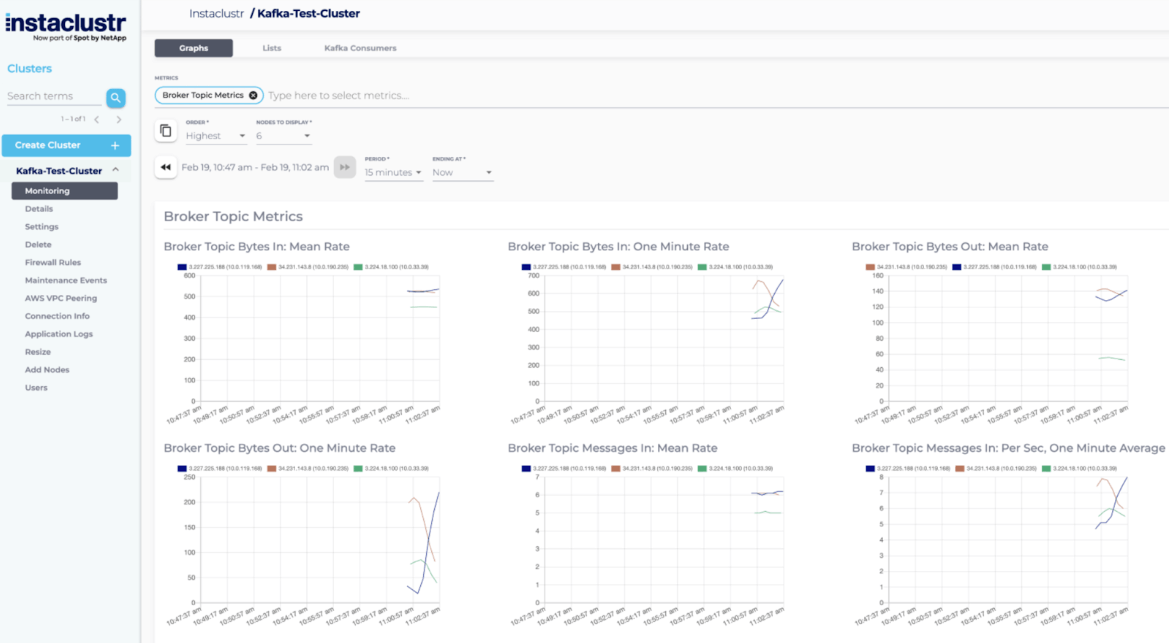What Is a managed OpenSearch platform?
A managed OpenSearch platform is a cloud-based service that automates the deployment, operation, and scaling of OpenSearch clusters. OpenSearch, a fork of the Elasticsearch project, is widely used for search, analytics, and observability workloads.
With a managed platform, users no longer need to manually handle the complexities of cluster operations, infrastructure setup, or routine maintenance tasks. Instead, the platform provider assumes responsibility for tasks such as provisioning resources, configuring nodes, monitoring clusters, and rolling out updates.
These platforms are designed for organizations wanting the capabilities of OpenSearch without the overhead of maintaining it themselves. They provide predictable performance, robust security controls, and scalability aligned with demand, making them suitable for production environments handling logs, metrics, or search workloads.
Key features of managed OpenSearch platforms
Automatic provisioning
Automatic provisioning allows users to launch OpenSearch clusters with minimal effort. Instead of manual setup, the platform automates resource allocation, software installation, and initial cluster configuration. This process ensures that best practices for security, reliability, and performance are implemented by default, lowering the risk of misconfiguration and reducing time-to-value for new projects.
Templates and wizards typically simplify onboarding, allowing users to specify requirements such as cluster size, storage, or networking, which the platform translates into a properly configured environment. In addition to initial setup, automatic provisioning extends to essential operational needs like updates and scaling.
Seamless horizontal/vertical scaling
Managed OpenSearch platforms enable seamless scaling both horizontally (adding nodes) and vertically (increasing the resources of existing nodes). Horizontal scaling is critical for accommodating increased data volumes or query loads, as adding nodes distributes the workload and maintains performance.
Vertical scaling helps accommodate changes in memory or CPU requirements for specific nodes, making it possible to fine-tune cluster performance based on observed workloads without redeploying the cluster. These scaling actions are typically performed with minimal disruption thanks to the orchestrated workflows built into managed services. Most platforms provide auto-scaling triggers or user-driven controls through management consoles or APIs.
Tiered storage capabilities
Tiered storage in managed OpenSearch platforms separates data across different storage classes based on age, importance, or access frequency. Hot data—recent and frequently queried indices—reside on high-performance storage for fast retrieval. Warm or cold data—older and less-accessed indices—can be migrated to more cost-effective, lower-performance storage tiers.
This method optimizes storage costs while preserving access to historical data for compliance, analytics, or audit requirements. These platforms automate the movement of data between storage tiers using lifecycle policies. Users can define retention periods and storage rules within the platform’s interface, and the system enforces these rules automatically.
Multi‑AZ deployment
Multi-Availability Zone (Multi-AZ) deployment increases resilience and high availability by spreading OpenSearch cluster nodes across multiple, isolated datacenter locations within a cloud region. If one AZ experiences a failure, nodes in other zones continue serving requests, reducing the chance of a total outage.
Managed OpenSearch platforms configure replication, shard allocation, and failover logic automatically, helping clusters survive infrastructure failures without data loss or significant downtime. The platform abstracts away the operational complexity of coordinating between AZs, including network routing and data synchronization. Administrators can verify health and failover readiness through dashboards.
Built-in monitoring and cluster health dashboards
Managed OpenSearch platforms include built-in monitoring to track resource utilization, query performance, node health, and storage status. Out-of-the-box dashboards provide real-time and historical views into cluster operations, surfacing metrics such as indexing rates, search latency, memory usage, and disk space consumption.
With these insights, users can troubleshoot issues faster, anticipate bottlenecks, and adjust configuration or resources before problems impact application performance. In addition to performance monitoring, dashboards help track events like node failures, shard relocations, and configuration changes. Platforms often offer integration with alerting systems and external observability tools, making it easier to build automated workflows for incident response.
Learn more in our detailed guide to OpenSearch dashboards
Vector search and AI integration
Vector search allows OpenSearch clusters to index and query unstructured data—such as text, images, or embeddings—using semantic similarity rather than keyword matches. Managed platforms provide native support for high-dimensional vector data and algorithms, enabling use cases like recommendation systems, natural language search, and anomaly detection.
This is crucial for organizations adopting machine learning and AI workloads, as it simplifies the integration of language models, image classifiers, or other AI systems with OpenSearch for fast, relevant results. AI integration can include features like anomaly detection, log analytics, and predictive insights. Managed OpenSearch platforms often provide connectors or APIs for importing model outputs and structured metadata directly into searchable indexes.
Notable managed OpenSearch platforms
1. NetApp Instaclustr

Instaclustr for OpenSearch delivers a fully managed and production-ready OpenSearch environment that empowers organizations to harness the full potential of their data. With comprehensive support for OpenSearch’s robust feature set, Instaclustr makes deploying, operating, and scaling OpenSearch clusters seamless and stress-free, ensuring the focus remains on deriving value from data rather than managing infrastructure.
Key features include:
- Scalable performance: Instaclustr for OpenSearch is built to handle workloads of any size, ensuring consistent performance as business and data grow.
- Real-time data insights: Low-latency search capabilities that empower processing and data analysis instantly for faster decision-making.
- Fully managed service: Instaclustr provides fully managed monitoring, maintenance, and upgrades for OpenSearch deployments.
- AI and vector search support: Leverage advanced AI capabilities and vector search to unlock deeper insights and improve search accuracy for Retrieval-Augmented Generation (RAG) and other use cases.
- Seamless integration: Easily connect with existing machine learning pipelines and tools for a streamlined workflow.
- Enterprise-grade security: Data protection with advanced encryption, access controls, and compliance support.
- 99.99% uptime SLA: Instaclustr is designed for reliability to keep operations running smoothly at all times.
- Cost transparency: With predictable pricing and no hidden fees, Instaclustr ensures investments are maximized.

2. Amazon OpenSearch Service

Amazon OpenSearch Service is a fully managed platform from AWS that simplifies the deployment, scaling, and operation of OpenSearch clusters. It supports a range of use cases including full-text search, log analytics, observability, and AI-powered applications.
Key features include:
- Managed operations: Automates setup, software updates, patching, and scaling, with monitoring and self-healing infrastructure.
- OpenSearch Serverless: Enables search and analytics without provisioning resources; automatically scales to match workload demands.
- AI and vector search support: Native vector search capabilities for semantic, multimodal, and Retrieval-Augmented Generation (RAG) use cases; integrates with Amazon Bedrock, SageMaker, and third-party model providers.
- Integrated data ingestion: OpenSearch Ingestion handles large-scale data pipelines with features like redaction, schema enforcement, and routing for compliance.
- Security: Offers encryption, access control, audit trails, and compliance support across industry standards.

Source: Amazon
3. DigitalOcean Managed OpenSearch

DigitalOcean Managed OpenSearch offers a simplified, managed solution for deploying and scaling OpenSearch clusters. Designed for developers and teams who want search and log analytics capabilities without managing infrastructure, it handles provisioning, scaling, updates, and backups.
Key features include:
- Simple deployment: Launch managed OpenSearch clusters with automated provisioning and configuration based on resource requirements.
- Simplified log management: Use OpenSearch’s log and observability features without worrying about cluster operations.
- Scalability: Dynamically scale CPU, RAM, and storage to meet workload growth.
- Automated backups: Receive hourly backups for the first 24 hours and daily backups for up to 3 days, depending on the plan.
- High availability: Monitoring, backup, and failover mechanisms reduce downtime and maintain data integrity.

Source: DigitalOcean
4. UpCloud OpenSearch

UpCloud Managed OpenSearch delivers fast, secure, and highly available search and analytics capabilities through a managed service. Intended for developers and organizations that need real-time insights without managing infrastructure, it enables cluster deployment, scaling, and global reach.
Key features include:
- Rapid deployment: Launch production-ready OpenSearch clusters with preconfigured infrastructure and optimized performance settings.
- Global reach: Deploy clusters across data centers in Europe, the US, Asia, and Australia to meet compliance needs and reduce latency.
- High availability: Benefit from multi-node clusters, automatic failover, and SLA-backed uptime.
- Scalable architecture: Scale RAM, CPU, and storage as workloads grow.
- Enterprise-grade security: Protect data using private networking, software-defined networking (SDN), encryption at rest and in transit, and custom firewall rules.

Source: UpCloud
5. Bonsai Managed OpenSearch

Bonsai Managed OpenSearch delivers a managed, production-ready OpenSearch experience backed by a team of search engineers. Unlike typical managed services, Bonsai combines technical operations with human expertise to ensure optimal performance, reliability, and cost efficiency.
Key features include:
- Search expertise: Access a team of search engineers who provide hands-on support, performance tuning, and upgrade management.
- Managed infrastructure: Bonsai handles provisioning, monitoring, patching, and scaling of OpenSearch clusters.
- High availability and resilience: Clusters are designed for continuous uptime with proactive alert response and automatic failover.
- Cost-efficient deployment: Deploy clusters in the organization’s AWS or Google Cloud environment to leverage reserved instances.
- Upgrades: Perform version, patch, and security upgrades using separate production, staging, and development clusters.

Source: Bonsai
Conclusion
Managed OpenSearch platforms simplify the complexities of deploying and operating OpenSearch clusters, making them accessible for teams without deep infrastructure expertise. By automating provisioning, scaling, monitoring, and data lifecycle management, these services allow organizations to focus on extracting value from their data rather than managing the underlying systems.